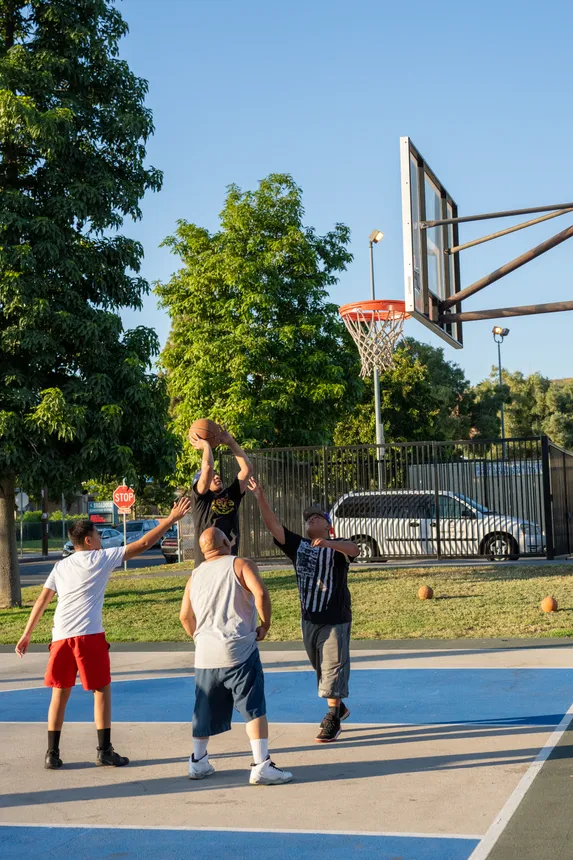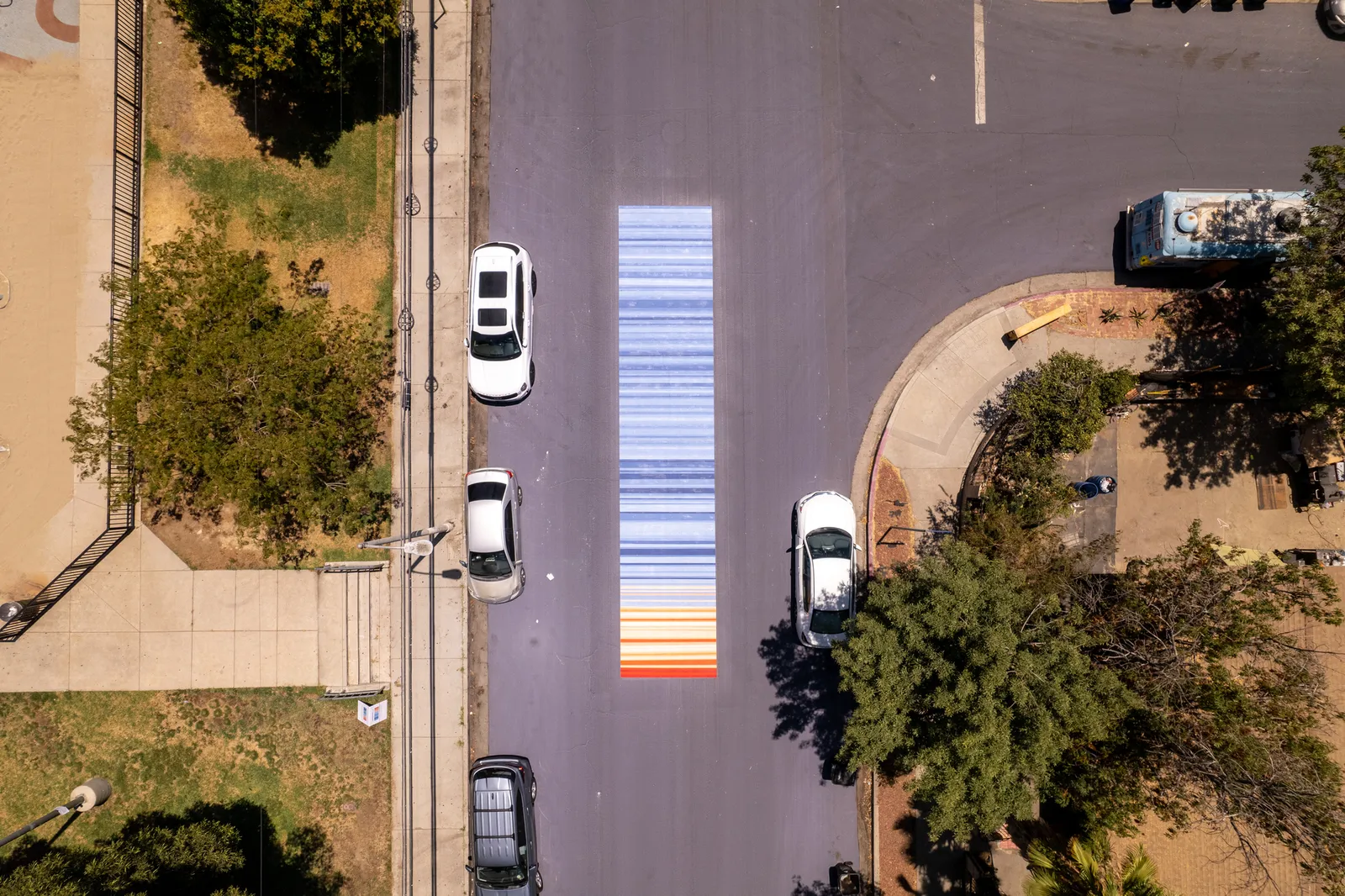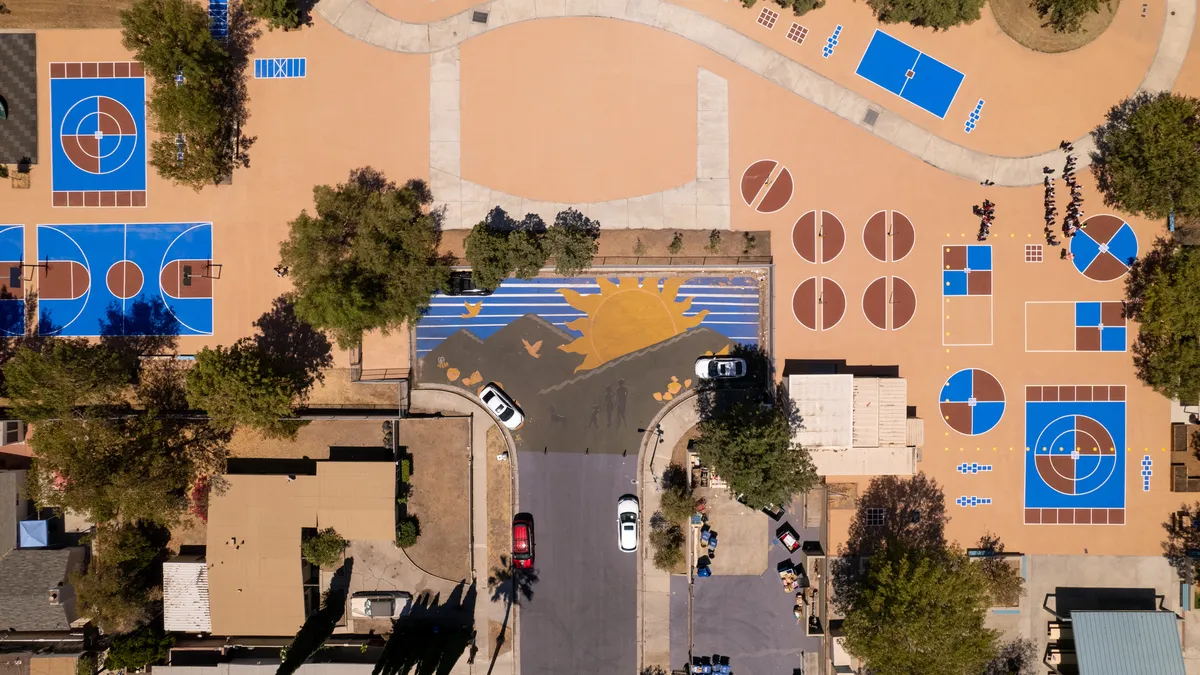The first community-wide cool pavement experiment is unfolding in the north Los Angeles neighborhood of Pacoima — and preliminary results are promising, according to the city and its partners on the project.
In July 2022, the city partnered with roofing manufacturer GAF to apply the company’s solar-reflective pavement coating to over 700,000 square feet of hard surfaces within a 10-block perimeter. That includes streets, a school playground, a basketball court and two parking lots in the neighborhood, which sits in the notoriously hot San Fernando Valley. Local nonprofits are also involved in the project, and artists covered some of the areas with colorful murals.
This summer, GAF is sharing its first eight months of data. Compared with a neighboring community without cool pavement, Pacoima saw ambient air temperatures 2 meters (about 6.5 feet) above ground that were on average 1.5 degrees F lower during sunny days and up to 3.5 degrees F cooler during a daytime extreme heat event. “The 2-meter mark was important because that’s kind of person height, and that was critically important,” said Jeff Terry, GAF’s vice president of corporate social responsibility and sustainability.
The pavement itself was 10 degrees F cooler on average on sunny days, and no negative impacts have been observed to date, GAF reported.
GAF meets with community members every three to four months, Terry said, and residents have said their tires are wearing less quickly and their shoes don’t stick to the hot road as much as they used to. Parents have told his team that they are more comfortable letting their kids play outside, and the parks and recreation department said they were able to schedule more summertime basketball leagues because they don’t have to confine players to indoor courts. Unexpectedly, the neighborhood downwind from Pacoima also experienced a slight cooling effect, Terry said.
“We’re very excited about the interim findings that we’ve had,” he noted, adding that residents of Pacoima and the neighboring reference community have asked for more cool pavement coating. “We’re just now digging significantly into the full-year data and only hope that we see improvements even upon what we’re sharing now.” The team is also working on models that could, for example, show potential impacts of scaling cool pavement to a 100-square-block area, Terry said.

The Pacoima project is by no means the first to experiment with the potential of cool pavement technology to reduce urban temperatures. For example, Los Angeles is deploying cool pavement on streets elsewhere in the city, and Phoenix celebrated in June its application of cool pavement coating on 100 miles of city streets. But the Pacoima project is “a first of its kind in terms of scope,” GAF’s preliminary report says, noting that the coating was applied in the same contiguous area and data is being continuously captured. The report called the project “one of the most comprehensive studies of an urban cooling intervention to date.”
To capture the data, GAF staff regularly drive across Pacoima and the neighboring reference community in an electric golf cart “jazzed up” with scientific equipment that measures “everything from dew point, barometric pressure, to wind speed to wind direction to temperature to albedo,” Terry said. “We’ve used drones, we use satellite [data], ultimately to … incorporate many, many data points into the evaluation.” There are also two weather stations in the community that collect data, he said.
Los Angeles City Councilmember Monica Rodriguez, who represents Pacoima, said the experienced impacts of cool pavement may not be drastic, but the technology can still be a meaningful part of a comprehensive approach to addressing urban heat islands. “I think it would be false for people to be like, ‘Oh my gosh, I feel it’s 10 degrees cooler where I’m standing,’” she said. “The intensity of the heat that we have in the San Fernando Valley, I can’t tell the difference between 110 and 100. It’s hot.”
But Pacoima is a community that doesn’t have enough trees or parks, she said, and that’s not changing any time soon due to the decades it takes trees to reach maturity. “We have to throw everything at it in communities like ours,” Rodriguez said. “This is a concurrent effort to mitigate those heat impacts in communities that don’t have the tree canopies, that are working-class neighborhoods.” She added that she’d love to see cool pavement implemented in neighborhoods across the city.
The murals on the cool pavement are a crucial part of the project, she added. “I think storytelling is very important, particularly for communities of color,” Rodriguez said. “They have to be seen. They have to be recognized and represented in the neighborhoods that they live in.” She noted that it’s important for artists to know they should avoid painting the pavement with black, a color that absorbs more heat than lighter colors.

Colorful murals can also spur community interest in and awareness of the project, she said. “If you paint something, it’s no longer blacktop and [if] it has a gray coating, you’re not going to think much of it,” she said. “But when you see the artwork, you’re going to be like, ‘Well, why did they do that? What is this?’”
The team is now rolling out the second phase of the project, in which it will implement cool roof technologies across the community. A final research report is expected in early 2024.












